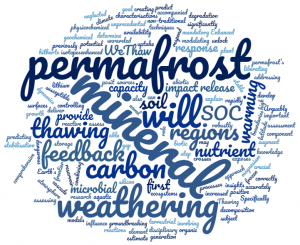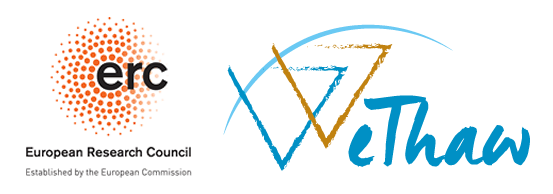Mineral Weathering in Thawing Permafrost: Causes and Consequences (WeThaw)
The challenge
Enhanced thawing of the permafrost in response to warming of the Earth’s high latitude regions exposes previously frozen soil organic carbon (SOC) to microbial decomposition, liberating carbon to the atmosphere and creating a dangerous positive feedback on climate warming. Thawing the permafrost may also unlock a cascade of mineral weathering reactions. These will be accompanied by mineral nutrient release and generation of reactive surfaces which will influence plant growth, microbial SOC degradation and SOC stabilisation. Arguably, weathering is an important but hitherto neglected component for correctly assessing and predicting the permafrost carbon feedback.

Project objectives
The goal of WeThaw is to provide a comprehensive assessment of the mineral weathering response in permafrost regions subject to thawing. By addressing this crucial knowledge gap, WeThaw will significantly augment our capacity to develop models that can accurately predict the permafrost carbon feedback.
The WeThaw project is a 5 year research effort funded by a European Research Council Starting Grant to Dr. Sophie Opfergelt at UCLouvain, Belgium.
The aim of the project WeThaw in the EU Research Journal.
Publications involving members of WeThaw
Hirst C., Monhonval A., Mauclet E., Thomas, M., Villani M., Ledman J., Schuur E.A.G., Opfergelt S. Evidence for late winter biogeochemical connectivity in permafrost soils. Communications Earth & Environment (Nature Group journal), 2023, 4, 85, https://doi.org/10.1038/s43247-023-00740-6 (Behind the paper)
Thomas M., Monhonval A., Hirst C., Bröder L., Zolkos S., Vonk J., Tank S.E., Keskitalo K.H., Shakil S., Kokelj S.V., van der Sluijs J., Opfergelt S. Evidence for preservation of organic carbon interacting with iron in material displaced from retrogressive thaw slumps: case study in Peel Plateau, west Canadian Arctic. Geoderma, 2023, in press.
Monhonval A., Hirst C., Strauss J., Schuur E.A.G., Opfergelt S. Strontium isotopes trace the dissolution and precipitation of mineral organic carbon interactions in thawing permafrost. Geoderma, 2023, in press.
Mauclet, E., Villani, M., Monhonval, A., Hirst, C., Schuur, E. A. G., Opfergelt, S. Quantifying stocks in exchangeable base cations in permafrost: a reserve of nutrients about to thaw, Earth Syst. Sci. Data Discuss. [preprint], https://doi.org/10.5194/essd-2022-240, 2022.
Mauclet E., Hirst C., Monhonval A., Stevenson E.I., Gérard M., Villani M., Dailly H., Schuur E.A.G., Opfergelt S. Tracing changes in base cation sources for Arctic tundra vegetation upon permafrost thaw. Geoderma, 2023, 429, 116277, https://doi.org/10.1016/j.geoderma.2022.116277.
Bröder L., C. Hirst, S. Opfergelt, M. Thomas, J. E. Vonk, N. Haghipour, T. I., Eglinton, and J. Fouché. Contrasting Export of Particulate Organic Carbon from Greenlandic glacial and nonglacial streams. Geophysical Research Letters, 2022, 49, e2022GL101210. https://doi.org/10.1029/2022GL101210
Monhonval, A., Strauss, J., Thomas, M., Hirst, C., Titeux, H., Louis, J., Gilliot, A., du Bois d'Aische, E., Pereira, B., Vandeuren, A., Grosse, G., Schirrmeister, L., Jongejans, L., Ulrich, M., Opfergelt, S. Thermokarst processes increase the supply of stabilizing surfaces and elements (Fe, Mn, Al, and Ca) for mineral-organic carbon interactions. Permafrost and Periglacial Processes, 2022, doi:10.1002/ppp.2162.
Villani, M., Mauclet, E., Agnan, A., Druel, A., Jasinski, B., Taylor, M., Schuur, E.A.G. and Opfergelt, S. Mineral element recycling in topsoil following permafrost degradation and a vegetation shift in sub-Arctic tundra. Geoderma, 2022, 421, 115915, doi.org/10.1016/j.geoderma.2022.115915.
Hirst, C., Mauclet, E., Monhonval, A., Tihon, E., Ledman, J., Schuur, E.A.G. and Opfergelt, S. Seasonal changes in hydrology and permafrost degradation control mineral element-bound DOC transport from permafrost soils to streams. Global Biogeochemical Cycles, 2022, 36(2). doi: 10.1029/2021GB007105.
Mauclet, E., Agnan, Y., Hirst, C., Monhonval, A., Pereira, B., Vandeuren, A., Villani, M., Ledman, J., Taylor, M., Jasinski, B. L., Schuur, E. A. G. and Opfergelt, S. Changing sub-Arctic tundra vegetation upon permafrost degradation: impact on foliar mineral element cycling, Biogeosciences, 2022, 19 (9), 2333-2351, doi:10.5194/bg-19-2333-2022.
Shmelev D., Cherbunina M., Rogov V., Opfergelt S., Monhonval A., Strauss J. Reconstructing permafrost sedimentological characteristics and post- depositional processes of the Yedoma stratotype Duvanny Yar, Siberia. Frontiers Earth Science, 2021, 9, 727315, doi:10.3389/feart.2021.727315.
Monhonval, A., Mauclet, E., Pereira, B., Vandeuren, A., Strauss, J., Grosse, G., Schirrmeister, L., Fuchs, M., Kuhry, P., Opfergelt, S., 2021. Mineral Element Stocks in the Yedoma Domain: A Novel Method Applied to Ice-Rich Permafrost Regions. Front. Earth Sci. 9, 773. doi.org/10.3389/feart.2021.703304
Monhonval, A., Strauss, J., Mauclet, E., Hirst, C., Bemelmans, N., Grosse, G., et al., 2021. Iron Redistribution upon Thermokarst Processes in the Yedoma Domain. Front. Earth Sci. 9, 629. doi:10.3389/feart.2021.703339
Hirst C., Opfergelt S., Gaspard F., Hendry K.R., Hatton J.E., Welch S., McKnight D., Lyons W.B. Silicon isotopes reveal a non-glacial source of silicon to Crescent Stream, McMurdo Dry Valleys, Antarctica. Frontiers Earth Science, 2020, 8:229, doi: 10.3389/feart.2020.00229.
Opfergelt S. The next generation of climate model should account for the evolution of mineral-organic interactions with permafrost thaw. Environ. Res. Lett., 2020, 15: 091003, doi.org/10.1088/1748-9326/ab9a6d
Monhonval, A., Opfergelt, S., Mauclet, E., Pereira, B., Vandeuren, A., Grosse, G., Schirrmeister, L., Fuchs, M., Kuhry, P., Strauss, J., 2020. Data from: Yedoma Domain Mineral Concentrations Assessment (YMCA). PANGAEA Digital Repository. doi:10.1594/PANGAEA.922724
Hatton J. E., Hendry K. R., Hirst C., Opfergelt S., Henkel S., Silva-Busso A., Welch S.A., Wadham J. L., Lyons W. B., Bagshaw E., Staubwasser M., McKnight D. Silicon isotopic composition of dry and wet-based glaciers in Antarctica. Frontiers Earth Science, 2020, 8:286, doi: 10.3389/feart.2020.00286
Bouchard F. , Agnan Y. , Bröder L. , Fouché J. , Hirst C. , Sjöberg Y. , Alexis M. , Behmel S. , Biskaborn B. K. , Christaki U. , Dean J. , Desyatkin A. , Farquharson L. , Fishback L. , Fortier D. , Fritz M. , Gandois L. , Hugelius G. , Jardillier L. , Jones B. M. , Kanevskiy M. , Lantuit H. , Laurion I. , Lebedeva L. , Opfergelt S. , Palmtag J. , Roy-Léveillée P. , Rudy A. , Séjourné A. , Siewert M. B. , Tank S. , Tanski G. , Teisserenc R. , Vonk J. E. and Zolkos S. (2020): The SPLASH Action Group – Towards standardized sampling strategies in permafrost science, Advances in Polar Science, 31 (3), doi: 10.13679/j.advps.2020.0009
Hatton J.E., Hendry K.R., Hawkings J.R.,Wadham J.L., Opfergelt S., Kohler T.J., Yde J.C., Stibal M., Žárský J.D.. Silicon isotopes in Arctic and sub-Arctic glacial meltwaters: the role of subglacial weathering in the silicon cycle. Proceedings Royal Society A, 2019, 475, 20190098.
Frontiers special issue on “Novel Isotope Systems and Biogeochemical Cycling During Cryospheric Weathering in Polar Environments” edited by K.R. Hendry, M.J. Murphy & S. Opfergelt
Murphy M.J., Hendry, K.R., Opfergelt S. (2021) Editorial: Novel isotope systems and biogeochemical cycling during cryospheric weathering in polar environments. Front. Earth Sci., 9, 660333, doi: 10.3389/feart.2021.660333

